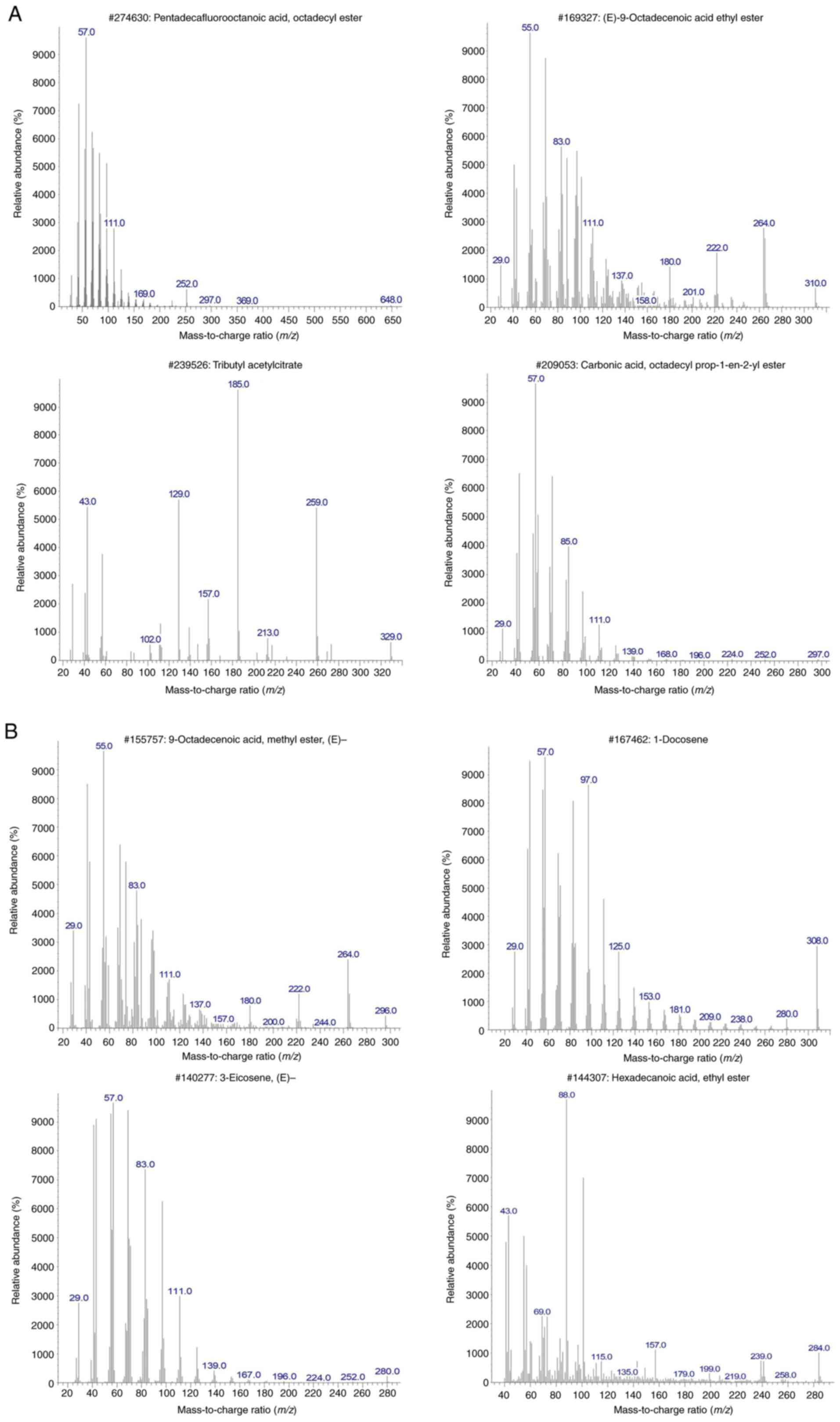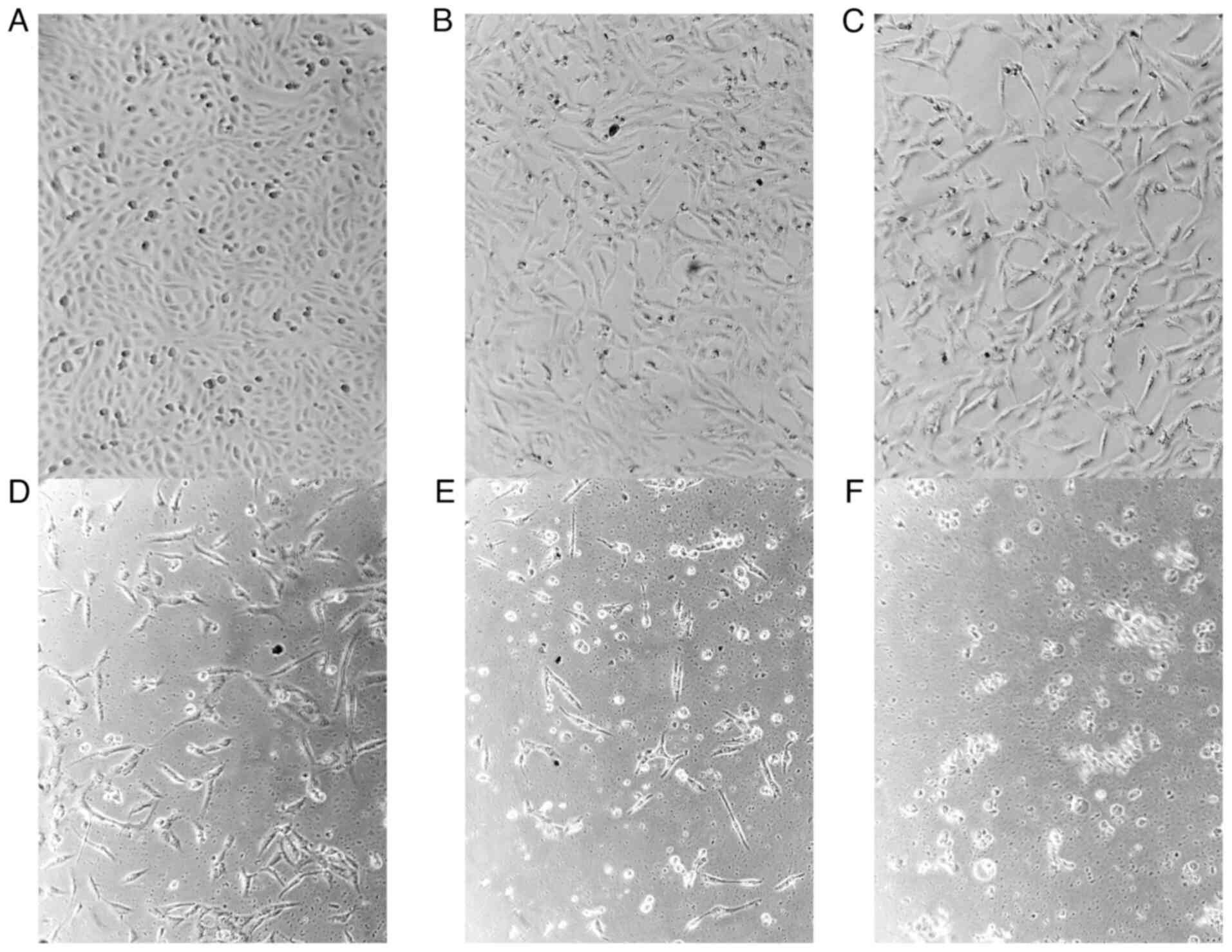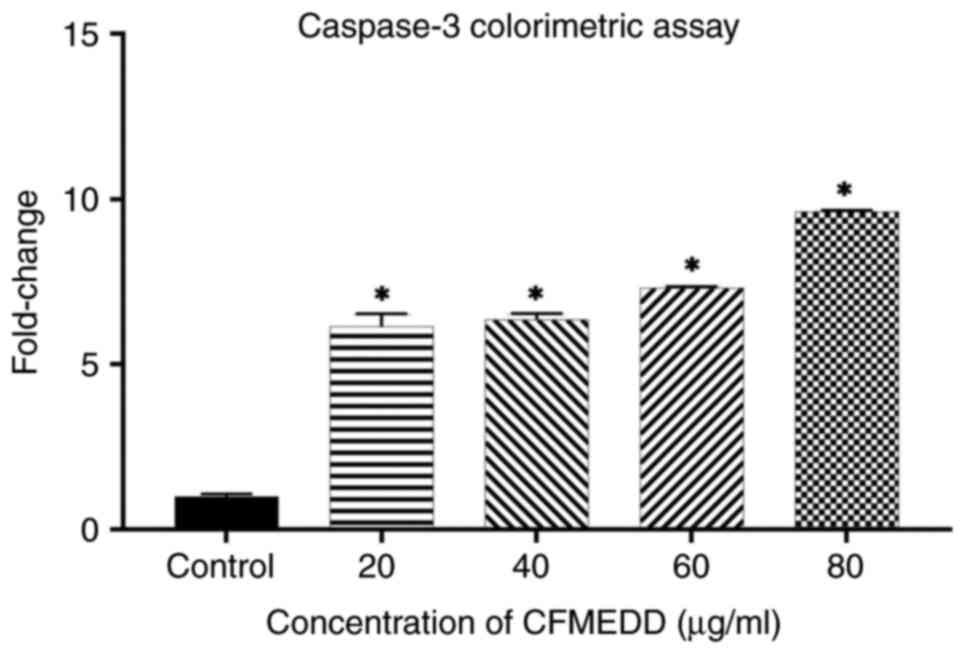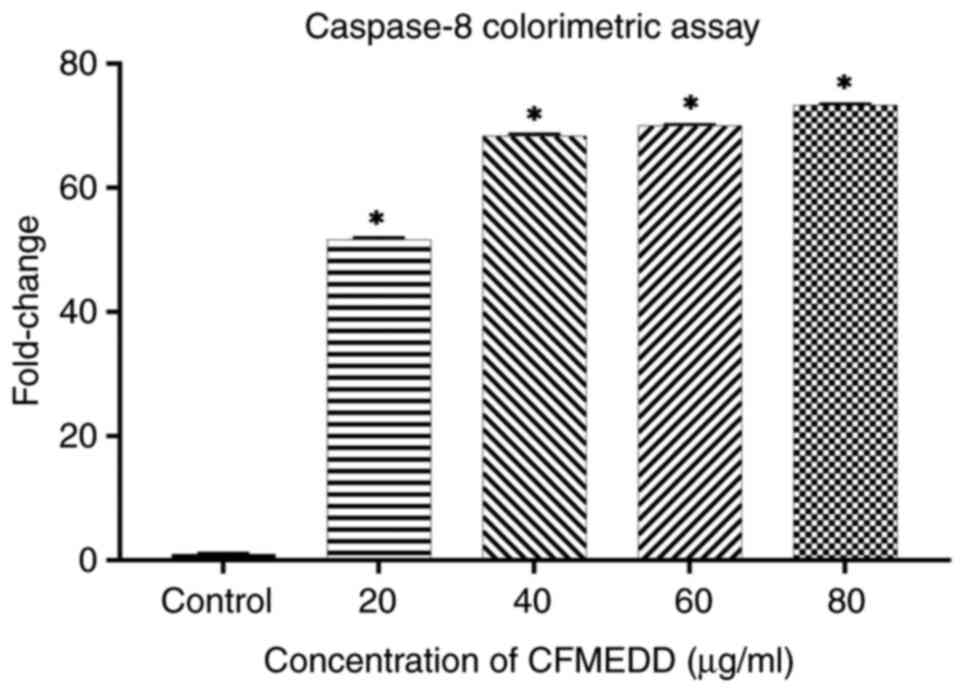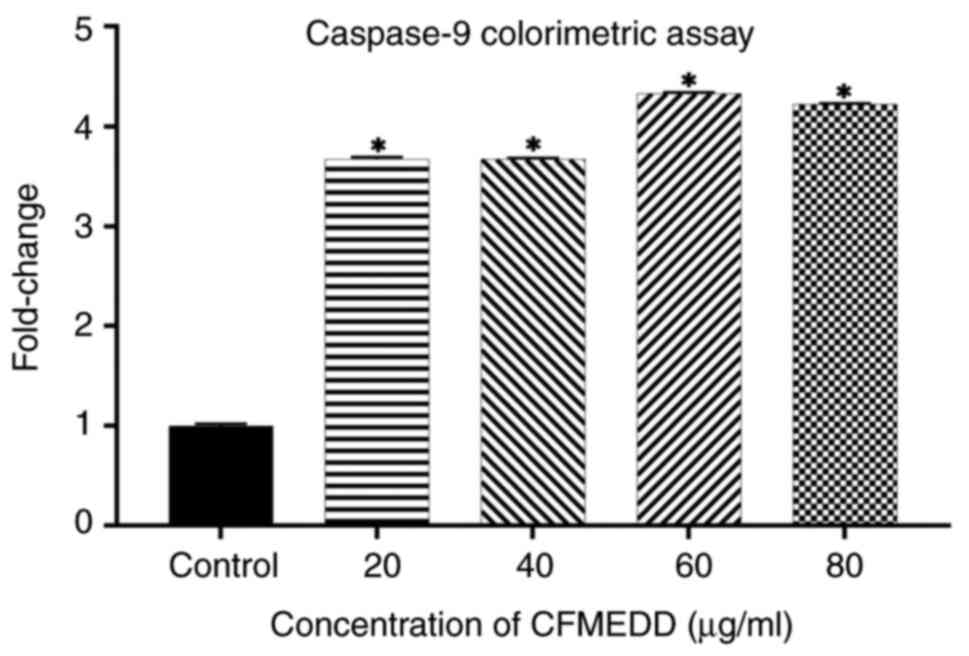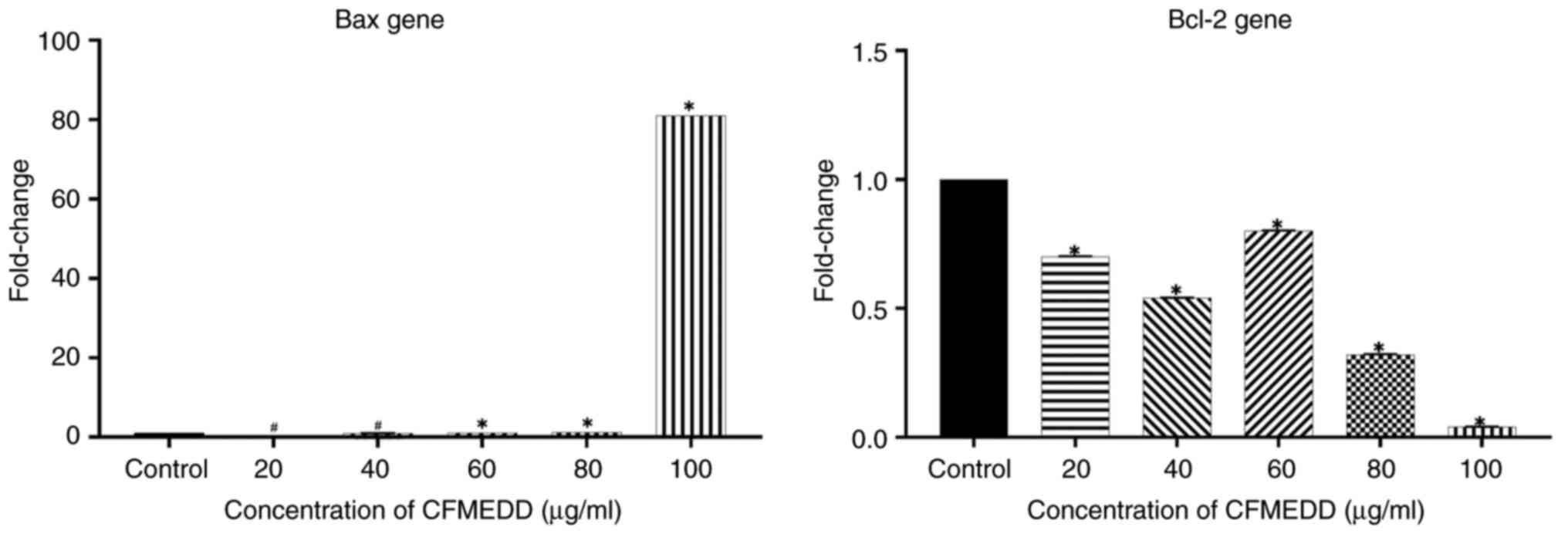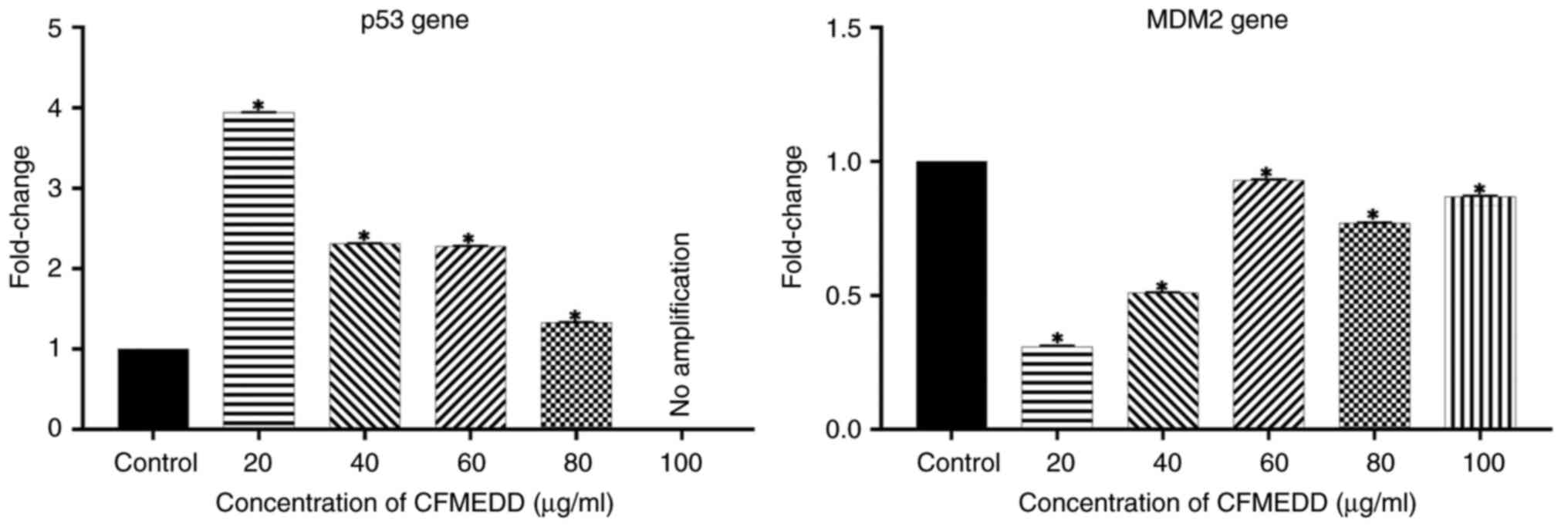Dioscorea dumetorum (bitter yam) tuber induces the apoptosis of liver cancer cells
- Authors:
- Published online on: February 14, 2025 https://doi.org/10.3892/wasj.2025.325
- Article Number: 37
-
Copyright : © Promise et al. This is an open access article distributed under the terms of Creative Commons Attribution License [CC BY 4.0].
Abstract
Introduction
Cancer is a major public health burden and is the second leading cause of mortality following cardiovascular diseases (1). Cancer is a genetic disease characterized by uncontrolled cell proliferation that usually invades and disrupts surrounding organs and tissues. This condition poses a serious public health concern in both developed and developing countries, in spite of current interventions (2). The regulation of growth stimulating and inhibiting pathways is a dependent factor for the growth and progression of healthy cells. Thus, alterations in the levels of proto-oncogenes and tumor suppressor genes that code for proteins, which regulate cell division, repair damaged DNA and initiate apoptosis, are known to cause cancers. The outcome of these alterations may be the production of cells that do not need external signals for cell division and growth (3). Genetic instability, aided by increased oxidative stress, results in the production of new tumor phenotypes with a reduction in apoptosis and an increase in tumor progression (4).
Cancer remains a main cause of morbidity and mortality, despite the notable advancements made in clinical interventions. Hepatocellular carcinoma (HCC) is known as primary liver cancer and has been reported as one of the leading causes of cancer-associated mortality that accounts for >80% of liver cancer cases (5,6). HCC is a malignant tumor with a high incidence rate that causes a dysregulation of metabolic enzymes (7-9). Among the risk factors of HCC are chronic hepatitis (hepatitis B and C virus) infections, obesity, alcohol abuse, autoimmune hepatitis, diabetes mellitus and metabolic diseases (10).
Conventionally, cancer management options include surgery, radiotherapy, immunotherapy and chemotherapy. However, due to the development of acquired or intrinsic chemo-resistance and the decrease in the levels of apoptotic proteins, the majority of the chemotherapeutic drugs used in the treatment of liver cancer, such as cisplatin, adriamycin, 5-fluorouracil, paclitaxel and doxorubicin have become ineffective (11). However, as regards liver cancer, clinically, no satisfactory method is available to date for its treatment. This situation renders the continuous search for novel and suitable alternatives imperative.
Generally, plants are known as essential sources of novel chemical entities suitable for anticancer drug discovery and development, and a number of plant species are currently in use for the treatment and prevention of cancer (12). Plants are known to contain compounds, such as phenols, flavonoids, tannins, alkaloids, lignans, terpenoids and quinones that contributes to therapeutic value in disease management (13). The bioactive components of plants have been used for the treatment of inflammation, infections and tumors. This practice is very common in poverty-stricken regions of the world and is based on oral tradition and folklore. In Nigeria for example, bitter yam, also known as Dioscorea dumetorum (D. dumetorum), is a tuber from the family, Diosoreaceae that is used by traditional medical practitioners for the treatment of diabetes, diarrhea, gonorrhea, jaundice, malaria, cancers and pain management (14,15). The bitter yam (doyar bisa in Hausa) is believed to contain numerous bioactive agents that contribute to its potency in traditional medicine. The Nigerian myth presumes that anything bitter is medicinal and has therapeutic potential. However, even though this myth has enabled the use of bitter yam for the local management of a number of diseases including cancer, there is limited scientific evidence available to support its anticancer properties. Therefore, the present study was designed to investigate the anticancer properties of D. dumetorum tubers in the HepG2 liver cancer cell line.
Materials and methods
Reagents and chemicals
The reagents used in the present study included trypsin-EDTA (MilliporeSigma), Roswell Park Memorial Institute (RPMI) medium (Gibco; Thermo Fisher Scientific, Inc.) and 3-(4,5-dimethylthiazolyl-2)-2,5-diphenyltetrazolium bromide (MTT) reagent (Sigma-Aldrich; Merck KGaA). Phosphate-buffered saline (PBS), trypan blue, dimethyl sulphoxide (DMSO), molecular grade water and analytical grade solvents (methanol, hexane, chloroform and ethyl-acetate) were obtained from MilliporeSigma.
Plant material
Fresh tubers of D. dumetorum (Kunth) Pax were purchased from the local morning market along Ahmadu Bello Way, Kaduna-North Local Government Area of Kaduna State, Nigeria. The tubers were identified and authenticated at the Herbarium, in the Department of Biological Sciences, Kaduna State University, Kaduna, Nigeria. The voucher specimen number assigned to the sample was KASU/BCH/0778.
Preparation of plant material
The yam tubers were washed, peeled and chopped into smaller sections that were dried under the shade. The dried chips were grinded using a domestic warring blender and maintained in an air-tight container prior to extraction.
Extraction of sample
For the extraction of the sample, ~1 kg of the powdered D. dumetorum tuber was soaked successively in hexane and methanol for 48 h each time at room temperature. The extracts were collected separately by filtration using a muslin cloth. Thereafter, the extracts were dried in a rotary evaporator (Heidolph Instruments GmbH & Co. KG) set at 40˚C. The extracts were weighed and stored at 4˚C for further use.
Bioassay guided fractionation of D. dumetorum
The crude hexane and methanolic extracts of D. dumetorum were subjected to cytotoxicity assay to identify the more active extract. The methanolic extract was more cytotoxic to the liver cancer cell line and was subjected to further fractionation using the modified solvent-solvent fractionation method as previously described (16). The methanolic extract (5 g) was mixed with a four-solvent system that included hexane, chloroform, ethyl acetate and water in a separating funnel at room temperature. The mixture was allowed to stand for 2 h for fractionation to occur. The solvent mixture fractionated based on their densities, each carrying different components of the bioactive methanolic extract. The fractions were collected separately and subjected to cytotoxicity assay.
Thin layer chromatography (TLC) profiling of the extracts
The methanolic extract of D. dumetorum and its fractions were subjected to TLC to evaluate the purity of the fractions. The procedure was performed using TLC plates (5x1 cm) (MilliporeSigma) pre-coated with silica gel. The mixtures to be resolved were spotted on the baseline of plates and placed in a beaker containing the mobile phase. The mobile phase was allowed to move through the plates by capillary action until it reached the solvent front. Thereafter, the plates were visualized under UV light and the retention factor (RF) values of spots (compounds) were calculated.
Gas chromatography-mass spectrometry (GC-MS) analysis
The most bioactive fraction (chloroform) of the methanolic extract of D. dumetorum was subjected to GC-MS analysis which was performed using the Mass Hunter GCMS system (Agilent Technologies, Inc.) with a 5975C Mass Spectrometer fitted with a HP5-MS capillary column. The interpretation of the mass spectral data was performed using the database of the National Institute Standard and Technology (NIST), which has >62,000 patterns. The mass spectra of the unknown components were compared with the spectra of the known components in the NIST library. The components of the test materials were identified by name, molecular weight and structure.
Cell line and culture
The HepG2 (liver cancer) cancer cell line (cat. no. HB-8065; American Type Culture Collection) and maintained at 37˚C in an incubator supplemented with 5% CO2. The HepG2 cells were grown in RPMI-1640 medium (Gibco; Thermo Fisher Scientific, Inc.) supplemented with 10% fetal bovine serum (FBS; Sigma-Aldrich, USA) and 1% penicillin-streptomycin (Thermo Fisher Scientific, Inc.). At 70 to 80% cell culture confluence, sub-culturing was routinely performed to maintain the cells.
Cytotoxicity assay (MTT assay)
The cytotoxicity study was performed using MTT assay, as previously described by Waziri et al (17). The HepG2 cells were seeded at a density of 2x103 cells per well for 24 h and treated with either 12.5, 25, 50, 100 or 200 µg/ml of the extract or fraction for 48 h, while 0.1% DMSO and doxorubicin (MilliporeSigma) in same treatment concentrations as the extract/fraction were used as negative and positive controls, respectively. Following 48 h of treatment, 20 µl MTT solution (5 mg/ml) were added to each well and the plate was re-incubated at 37˚C for 2 h. The reaction was terminated by the addition of 150 µl DMSO to solubilize the MTT-formazan crystals formed by metabolically viable cells. The optical density was measured at 570 nm using an xMark microplate spectrophotometer (Bio-Rad Laboratories, Inc.). Each experiment was repeated three times, and each dilution had at least three replicates. The percentage cytotoxicity was calculated using the following formula:
Cell morphology assay
The effects of the chloroform fraction of D. dumetorum on HepG2 cells were monitored using phase contrast microscopy. The cells were seeded in a 6-well plate at a density of 5x104 cells/well overnight and treated with various concentrations (20, 40, 60 80 and 100 µg/ml) of the chloroform fraction of the methanol extract of D. dumetorum for 24 h. Thereafter, the cells were viewed under a phase contrast microscope (AmScope).
Caspase-3, -8 and -9 assays
Using the Caspase-3 colorimetric assay kit (cat. no. K106-100, BioVision), the effects of the chloroform fraction of D. dumetorum on the apoptosis of HepG2-cells were investigated. Briefly, the cells were seeded overnight in a 96-well plate at a density of 1x104 cells per well and treated with 20, 40, 60, 80 and 100 µg/ml of the chloroform fraction for 24 h. Thereafter, the cells were harvested using trypsin and centrifuged at 20.12 x g for 5 min at 4˚C to obtain pellets. The cell pellets were washed with PBS and re-suspended in 50 µl chilled (4˚C) Cell Lysis Buffer in the assay kit before incubating on ice for 10 min for lysis to occur. Following incubation on ice, the cells were centrifuged at 20,124 x g for 1 min at 4˚C to collect supernatant for protein quantification to ensure even protein concentrations in all samples. Approximately 50 µl of each supernatant was mixed with 50 µl 2X Reaction Buffer in the assay kit (containing 10 mM DTT) in a 96-well plate. This was followed by the addition of 5 µl of 4 mM DEVD-pNA in the assay kit (200 µM, final concentration) and incubation for 2 h at 37˚C. The same procedure was repeated for the caspase-8 (cat. no. 113-100) and -9 (cat. no. K119-100) assays using their respective assay kits. The optical density (OD) of each sample was measured at 405 nm using the xMark microtiter spectrophotometer (Bio-Rad Laboratories, Inc.) and the fold change was calculated relative to the negative control.
Gene expression assay. RNA isolation
RNA was isolated from the chloroform fraction-treated HepG2 cells using the GF-1 total RNA extraction kit (Vivantis Technologies Sdn Bhd). Following treatment with increasing concentrations of the chloroform fraction, the cells were harvested and centrifuged at 20.12 x g for 5 min at 4˚C to collect the pellets. Subsequently, ~350 µl Buffer TR in the extraction kit was added to the pellets (suspended in 50 µl PBS) and thoroughly mixed by vortexing to produce cell lysate, which was transferred into a homogenization column assembled in a collection tube and centrifuged at 46,887 x g for 2 min at 4˚C. The flow through was saved and equal volume of 80% ethanol was added and mixed gently. Subsequently, ~650 µl of the mixture were transferred into an RNA Binding Column provided along with the kit, fitted to a collection tube and spun at 20,124 x g for 1 min at 4˚C. The flow through was discarded and 500 µl Wash Buffer in the assay kit was added to the Binding Column and centrifuged at maximum speed (46,887 x g) for 1 min at 4˚C prior to the addition of 70 µl DNase I Digestion Mix and the mixture was incubated for 15 min at room temperature. Following incubation, 500 µl Inhibition Removal Buffer was added and centrifuged at maximum speed (46,887 x g) for 1 min at 4˚C to discard the flow through. The pellets in the Binding column were washed twice each with 500 µl Wash Buffer, in each case the flow through was discarded following centrifugation at 20,124 x g for 1 min at 4˚C. RNA was finally collected by the addition of 60 µl RNase-free Water directly on the membrane of the RNA Binding Column fitted into a new Eppendorf tube (1.5 ml; Eppendorf AG, Hamburg, Germany) and centrifuged for 1 min at 20,124 x g at 4˚C to collect the pure RNA. The RNA was quantified at 260 nm using a NanoDrop® spectrophotometer (Thermo Fisher Scientific, Inc.) and stored at -20˚C.
cDNA synthesis. The RNA extracted was transcribed into cDNA using ReverTra Ace™ qPCR RT Master Mix with gDNA Remover (Toyobo Co., Ltd.). For genomic DNA removal, the DNase I reaction solution was prepared comprising of 2 µl of 4X DN master mix, 6 µl of RNA template (0.5 µg) and 2 µl of nuclease free water and incubated for 5 min at 37˚C. For the reverse transcription, 2 µl of 5X RT master mix II was added and incubated first at 37˚C for 15 min, and 50˚C for 5 min and finally heated at 98˚C for 5 min to terminate the reverse transcription. The cDNA synthesized was stored at -20˚C for further analysis.
Primer design. The primers for the apoptosis related genes were designed on the NCBI website using Primer-BLAST software (Primer3, version 2.5.0). The primers used are listed in Table I. They were synthesized by Integrated DNA Technologies (IDT). Each primer was provided in a lyophilized form and reconstituted to a stock concentration of 100 µM using nuclease-free water.
Reverse transcription-quantitative PCR (RT-qPCR). The expression of the apoptotic genes was evaluated by RT-qPCR using SYBR-Green master mix (Toyobo Co., Ltd.) and the synthesized primers (Table I), while β-actin was used as the reference gene. PCR was performed as follows: 95˚C for 60 sec of initial denaturation, followed by 40 cycles of 95˚C for 15 sec and 60˚C for 30 sec. The relative expression of each gene was performed using the 2-ΔΔCq method (18).
Statistical analysis
All experiments were performed in triplicate. The statistical software package SPSS (version 27, IBM Corp.) was used to analyze the data. One-way analysis of variance (ANOVA) was conducted to compare the mean values between control and treatment groups at the 95% confidence level, followed by Tukey's post hoc test to identify specific group differences. Data obtained from the study are expressed as the mean ± standard deviation (SD). A value of P<0.05 was considered to indicate a statistically significant difference.
Results
Results of GC-MS analysis
The GC-MS analysis revealed that the chloroform fraction was composed mainly of pentadecafluorooctanoic acid, (E)-9-octadecenoic acid ethyl ester (elaidic acid), tributyl acetyl citrate, octadecyl prop-1-en-2-yl ester, 9-octadecenoic acid (oleic acid), 1-docosene, 3-eicosene, and hexadecanoic acid (palmitic acid) (Table II and Fig. 1A and B).
Cytotoxic effects of the extract on HepG2 cells
The methanolic extract had a lower IC50 value (29.84±0.004 µg/ml) than the hexane extract (50.54±0.004 µg/ml) of D. dumetorum, while that of doxorubicin (standard drug) was the lowest, as shown in Table III. The IC50 value of the methanol extract was significantly (P<0.05) lower than that of the hexane extract and was selected for further fractionation. Of the fractions of the methanolic extract of D. dumetorum screened, the chloroform fraction was the most active with the lowest IC50 value (28.5±0.00 µg/ml), followed by the ethyl acetate fraction (31.69±0.03 µg/ml), hexane fraction (52.02±0.03 µg/ml) and aqueous fraction (86.28±0.05 µg/ml). For this reason, the chloroform fraction was selected as the fraction used for the treatment of the HepG2 cancer cell line.
Table IIIIn vitro cytotoxic effects of the crude extracts and methanol sub-fractions of Dioscorea dumetorum tuber on HepG2 (liver cancer) cells. |
Effect of the chloroform fraction of the methanolic extract of D. dumetorum (CFMEDD) on HepG2 cell morphology
Treatment with the chloroform fraction caused increased HepG2 cell death and distorted cell morphology (Fig. 2B-F). The formation of round-shaped and floating cells is an evidence of cell death, and this feature was more prominent in the cells treated with the highest concentration of the extract (Fig. 2F). In addition, the chloroform fraction-treated cells exhibited a distorted cell morphology and signs of chromatin condensation, which is a feature of apoptosis. The phase contrast micrograph revealed an intact cell morphology in the negative control-treated cells (Fig. 2A).
The chloroform fraction increases the expression of caspase-3, -8 and -9 in HepG2 cells
Treatment with the chloroform fraction significantly increased (P<0.05) the protein expression levels of caspase-3 and -8 in a concentration-dependent manner (Figs. 3 and 4). As regards caspase-9, its expression significantly increased as the treatment concentration increased from 20 to 60 µg/ml, and decreased slightly at the concentration of 80 µg/ml (Fig. 5). The expression of the caspases in the treated cells was significantly (P<0.05) higher than that of the untreated cells (negative control). Caspase-8 is main caspase of the death receptor pathway, while caspase-9 is the main caspase of the mitochondrial pathway.
Effects of chloroform fraction on mRNA expression in HepG2 cells
As shown in Fig. 6, the treatment caused a significant (P<0.05) increase in the mRNA expression of Bax at a dose of 100 µg/ml and a significant (P<0.05) decrease in Bcl-2 mRNA corresponding to the treatment concentration. In a similar manner, the chloroform fraction treatment caused a significant (P<0.05) increase in the mRNA expression of p53 compared with the control cells (Fig. 7). Conversely, the mRNA expression of the oncogene, murine double minute 2 (MDM2) significantly (P<0.05) decreased compared with the negative control cells (Fig. 7).
Discussion
The present study was performed to evaluate the mechanisms of action of the CFMEDD on HepG2 (liver cancer) cells. The results revealed that CFMEDD induced greater cytotoxic effects than all fractions in HepG2 cells with an IC50 value of 28.45±0.00 µg/ml, while the IC50 value of the standard drug, doxorubicin, was 11.0±0.01 µg/ml. Of the eight major compounds identified by the GC-MS analysis of the chloroform fraction, octadecenoic and hexadecenoic acids have been reported to demonstrate in vitro anticancer properties. Specifically, octadecenoic acid was found to demonstrate significant anti-proliferative effect on human gastric (SGC-7901), hepatocellular carcinoma (BEL-7402), and leukaemia (HL-60) tumour cell strains, while hexadecenoic acid was previously used in the treatment of breast, colon and liver cancers (19-21). Therefore, it was suspected that both octadecenoic and hexadecenoic acids may have contributed to the cytotoxicity of the chloroform fraction of HepG2 cancer cell lines in the present study.
The examination of HepG2 cell morphology following treatment with CFMEDD provides valuable insight into the cytotoxic effects at a cellular level. Herein, the phase contrast micrographs (Fig. 2) demonstrated a dose-dependent alteration in HepG2 cell morphology, including certain features of apoptosis, such as chromatin condensation and cell membrane disruption. Chromatin condensation, cell shrinking and membrane blebbing are events that precede the formation of apoptotic bodies and eventual apoptosis (22-25). In the present study, the protein expression of caspase-3, -8 and -9 in HepG2 cells significantly increased following treatment with the CFMEDD. Caspase-9 is an initiator of apoptosis via the mitochondrial pathway, while caspase-8 initiates apoptosis via the extrinsic death receptor pathway. The findings of the present study suggest that CFMEDD induces the apoptosis of liver cancer cells via both the mitochondrial and extrinsic pathways of apoptosis. Both the extrinsic and intrinsic pathways are closely linked (26). Caspase-8 is negatively controlled by anti-apoptotic proteins. The loss of caspase-9 promoter or gene functions that lead to a reduced caspase-9 activity has been implicated as one of the causes of cancer development (27). Caspase-3 is an executioner of cell apoptosis whose activation is triggered by both caspase-8 and -9. It was hypothesized that both caspase-8 and -9 may have triggered the increased expression of caspase-3 in the present study. Caspase-3 executes apoptosis via the selective destruction of subcellular structures, organelles and the genome (28). The increased expression of caspase-3 and -9 has also been reported in liver cancer cells treated with clausenidin isolated from Clausena excavata (17). In addition, activated caspases cleave at least 100 different proteins that are responsible for DNA replication, transcription, translation, phosphorylation and dephosphorylation. The caspases can also cleave the inhibitor of caspase activated DNase complex to release active DNase in certain tissues. Activated DNases are responsible for the internucleosomal cleavage of genomic DNA to produce smaller fragments (29). The activity of DNases also produces morphological alterations in cells. In the present study, phase contrast micrographs revealed features typical of apoptosis that could have been triggered by DNase activity.
In the present study, the results of RT-qPCR provided further evidence of the involvement of the intrinsic mitochondrial pathway in the apoptosis of liver cancer cells in vitro. The treatment of HepG2 cancer cell lines with the CFMEDD resulted in a significant decrease in the levels of Bcl-2 and MDM2 genes in a concentration-dependent manner. These two genes function to prevent the apoptosis of cancer cells. Specifically, the Bcl-2 family genes play a key role in intrinsic mitochondrial apoptosis (30). Bcl-2 protein is an anti-apoptotic protein that interacts with pro-apoptotic proteins, such as Bax, limiting pore development and the release of cytochrome c (31). On the other hand, an increase in Bax expression causes tumor cells to die, resulting in cell death, while an increase in Bcl-2 expression prevents cell death (32). In the present study, it was hypothesized that the apoptosis of HepG2 cells may have been triggered via the decreased expression of the Bcl-2 gene in the treated cells.
Furthermore, the gene expression analysis performed herein revealed the upregulation of the tumor suppressor gene, p53, and the downregulation of the oncogene, MDM2. Cancer is a product of mutations conferred by oncogenes with dominant survival characteristics and the downregulation of tumor suppressor genes (33). Gene mutations do not occur with great efficiency due to the existence of DNA surveillance and the repair system under the control of tumor suppressors, such as the p53 gene. The majority of cancers are the result of damage to the p53 gene. However, the present study revealed a significant increase in p53 gene expression in the treated cells. p53 generates numerous signals that lead to the apoptosis of cancer cells. On the other hand, MDM2 is a negative regulator of p53 and other proteins involved in DNA repair and apoptosis (34). In fact, MDM2 leads to the destruction of p53 and to the consequent development of cancers. The interaction between MDM2 and p53 is detrimental to cells, as it decreases p53 activity and enables cells to escape apoptosis. Therefore, a number of anticancer agents target the inhibition of the MDM2-p53 interaction (10,35). The lower the expression of the MDM2 gene, the higher the expression of the p53 gene, and its consequent activity. In the present study, treatment with CFMEDD led to the decreased expression of MDM2, which may have enabled the p53-mediated apoptosis of the HepG2 cancer cells. Therefore, it was hypothesized that this may be one of the mechanisms of action of the CFMEDD in HepG2 cells.
In addition, the expression of Bax mRNA began to increase at concentrations >60 µg/ml and reached its peak at the concentration of 100 µg/ml. At this highest concentration (100 µg/ml), a >80-fold increase in the expression of the Bax gene was observed in the CFMEDD-treated HepG2 cells. Conversely, Bcl-2 expression significantly decreased (P<0.05) in a concentration-dependent manner. Bcl-2 is an anti-apoptotic gene that enables tumor cells to survive, while Bax is a pro-apoptotic gene that enables tumors to undergo apoptosis. The decision on whether a cell should undergo apoptosis depends on the ratio of Bax to Bcl-2. Apoptosis is lost when there is an overexpression of Bcl-2, as reported in a number of cancers (36). In the present study, treatment of the HepG2 cells with CFMEDD significantly downregulated the expression of the Bcl-2 gene, and this may have triggered the onset of the apoptosis of the HepG2 cells. p53 protein is known to activate Bax protein for apoptosis to occur in cells (37). The present study observed a significant increase in the expression of Bax mRNA, whose translation leads to the production of Bax protein.
In conclusion, the present study demonstrates that, amongst other mechanisms, the Bax gene induces the apoptosis of CFMEDD-treated HepG2 cells, triggered by p53 activation. From the findings presented herein, it can be concluded that CFMEDD holds promise as a potential therapeutic agent for the treatment of liver cancer due to its ability to induce the apoptosis of HepG2 cells via the extrinsic and intrinsic pathways.
Acknowledgements
Not applicable.
Funding
Funding: No funding was received.
Availability of data and materials
The data generated in the present study may be requested from the corresponding author.
Authors' contributions
All authors (CVP, PMW, RA, DT, MIT and AEA) were involved in the conception and design of the study. CVP and PMW provided the materials (reagents and chemicals used). CVP, DT, MIT and AEA were involved in the in vitro assays. DT performed the statistical analysis of the data. CVP and DT were involved in the interpretation of data. PMW and RA were involved in the reviewing and editing of the manuscript. PMW and DT confirm the authenticity of all the raw data and all authors have read and approved the final version of the manuscript.
Ethics approval and consent to participate
Not applicable.
Patient consent for publication
Not applicable.
Competing interests
The authors declare that they have no competing interests.
References
|
World Health Organization: Cancer: Key facts. WHO, Geneva, 2018. https://www.who.int/news-room/fact-sheets/detail/cancer. Accessed February 7, 2019. | |
|
Tariq A, Sadia S, Pan K, Ullah I, Mussarat S, Sun F, Abiodun OO, Batbaatar A, Li Z, Song D, et al: A systematic review on ethnomedicines of anti-cancer plants. Phytother Res. 31:202–264. 2017.PubMed/NCBI View Article : Google Scholar | |
|
Aliyu-Amoo H, Isa HI, Njoya EM and McGaw LJ: Antiproliferative effect of extracts and fractions of the root of Terminalia avicennioides (Combretaceae) Guill and Perr. On HepG2 and Vero Cell Lines. Int J Phytomed Phytother. 7(71)2021. | |
|
Kadan S, Rayan M and Rayan A: Anticancer activity of anise (Pimpinella anisum L.) seed extract. Open Nutraceuticals J. 6:1–5. 2013. | |
|
Wang Z, Li Z, Ye Y, Xie L and Li W: Oxidative stress and liver cancer: Etiology and therapeutic targets. Oxid Med Cell Longev. 2016(7891574)2016.PubMed/NCBI View Article : Google Scholar | |
|
Sung H, Ferlay J, Siegel RL, Laversanne M, Soerjomataram I, Jemal A and Bray F: Global cancer statistics 2020: GLOBOCAN estimates of incidence and mortality worldwide for 36 cancers in 185 countries. CA Cancer J Clin. 71:209–249. 2021.PubMed/NCBI View Article : Google Scholar | |
|
Maluccio M and Covey A: Recent progress in understanding, diagnosing, and treating hepatocellular carcinoma. CA Cancer J Clin. 62:394–399. 2012.PubMed/NCBI View Article : Google Scholar | |
|
Sun Y, Ma W, Yang Y, He M, Li A, Bai L, Yu B and Yu Z: Cancer nanotechnology: Enhancing tumor cell response to chemotherapy for hepatocellular carcinoma therapy. Asian J Pharm Sci. 14:581–594. 2019.PubMed/NCBI View Article : Google Scholar | |
|
Nekvindova J, Mrkvicova A, Zubanova V, Hyrslova Vaculova A, Anzenbacher P, Soucek P, Radova L, Slaby O, Kiss I, Vondracek J, et al: Hepatocellular carcinoma: Gene expression profiling and regulation of xenobiotic-metabolizing cytochromes P450. Biochem Pharmacol. 177(113912)2020.PubMed/NCBI View Article : Google Scholar | |
|
Florio AA, Campbell PT, Zhang X, Zeleniuch-Jacquotte A, Wactawski-Wende J, Smith-Warner SA, Sinha R, Simon TG, Sesso HD, Schairer C, et al: Abdominal and gluteofemoral size and risk of liver cancer: The liver cancer pooling project. Int J Cancer. 147:675–685. 2020.PubMed/NCBI View Article : Google Scholar | |
|
Manosroi A, Akazawa H, Kitdamrongtham W, Akihisa T, Manosroi W and Manosroi J: Potent antiproliferative effect on liver cancer of medicinal plants selected from the Thai/Lanna medicinal plant recipe database ‘MANOSROI III’. Evid Based Complement Alternat Med. 2015(397181)2015.PubMed/NCBI View Article : Google Scholar | |
|
Khalil R, Ali Q, Hafeez M and Malik A: Phytochemical activities of Conocarpus erectus: An overview. Biol Clin Sci Res J. 2020:1–6. 2020. | |
|
Kaur R, Kapoor K and Kaur H: Plants as a source of anticancer agents. J Nat Prod Plant Resour. 1:19–124. 2011. | |
|
Jesus M, Martins AP, Gallardo E and Silvestre S: Diosgenin: Recent highlights on pharmacology and analytical methodology. J Anal Methods Chem. 2016(4156293)2016.PubMed/NCBI View Article : Google Scholar | |
|
Salehi B, Sener B, Kilic M, Sharifi-Rad J, Naz R, Yousaf Z, Mudau FN, Fokou PVT, Ezzat SM, El Bishbishy MH, et al: Dioscorea plants: A genus rich in vital nutra-pharmaceuticals-A review. Iran J Pharm Res. 18(Suppl):68–89. 2019.PubMed/NCBI View Article : Google Scholar | |
|
Keshava R, Muniyappa N and Gope R: Bioactivity guided fractionation and elucidation of anti-cancer properties of Imperata cylindrica leaf extracts. Asian Pac J Cancer Prev. 21:707–714. 2020.PubMed/NCBI View Article : Google Scholar | |
|
Waziri PM, Abdullah R, Yeap SK, Omar AR, Kassim NK, Malami I, How CW, Etti IC and Abu ML: Clausenidin induces caspase-dependent apoptosis in colon cancer. BMC Complement Altern Med. 16(256)2016.PubMed/NCBI View Article : Google Scholar | |
|
Livak KJ and Schmittgen TD: Analysis of relative gene expression data using real-time quantitative PCR and the 2(-Delta Delta C(T)) method. Methods. 25:402–408. 2001.PubMed/NCBI View Article : Google Scholar | |
|
Win DT: Oleic acid-The anti-breast cancer component in olive oil. AU J.T. 9:75–78. 2005. | |
|
Yu F, Lu S, Yu F, Shi J, McGuire PM and Wang R: Cytotoxic activity of an octadecenoic acid extract from Euphorbia kansui (Euphorbiaceae) on human tumour cell strains. J Pharm Pharmacol. 60:253–259. 2008.PubMed/NCBI View Article : Google Scholar | |
|
Sangpairoj K, Settacomkul R, Siangcham T, Meemon K, Niamnont N, Sornkaew N, Tamtin M, Sobhon P and Vivithanaporn P: Hexadecanoic acid-enriched extract of Halymenia durvillei induces apoptotic and autophagic death of human triple-negative breast cancer cells by upregulating ER stress. Asian Pac J Trop Biomed. 12:132–140. 2022. | |
|
Elmore S: Apoptosis: A review of programmed cell death. Toxicol Pathol. 35:495–516. 2007.PubMed/NCBI View Article : Google Scholar | |
|
Häcker G: The morphology of apoptosis. Cell Tissue Res. 301:5–17. 2000.PubMed/NCBI View Article : Google Scholar | |
|
Pfeffer CM and Singh ATK: Apoptosis: A target for anticancer therapy. Int J Mol Sci. 19(448)2018.PubMed/NCBI View Article : Google Scholar | |
|
Obeng E: Apoptosis (programmed cell death) and its signals-A review. Braz J Biol. 81:1133–1143. 2021.PubMed/NCBI View Article : Google Scholar | |
|
Lossi L: The concept of intrinsic versus extrinsic apoptosis. Biochem J. 479:357–384. 2022.PubMed/NCBI View Article : Google Scholar | |
|
Olsson M and Zhivotovsky B: Caspases and cancer. Cell Death Differ. 18:1441–1449. 2011.PubMed/NCBI View Article : Google Scholar | |
|
Hanahan D and Weinberg RA: The hallmarks of cancer. Cell. 100:57–70. 2000.PubMed/NCBI View Article : Google Scholar | |
|
Nagata S: Apoptotic DNA fragmentation. Exp Cell Res. 256:12–18. 2000.PubMed/NCBI View Article : Google Scholar | |
|
Gross A, McDonnell JM and Korsmeyer SJ: BCL-2 family members and the mitochondria in apoptosis. Genes Dev. 13:1899–1911. 1999.PubMed/NCBI View Article : Google Scholar | |
|
Cheng EH, Wei MC, Weiler S, Flavell RA, Mak TW, Lindsten T and Korsmeyer SJ: BCL-2, BCL-XL sequester BH3 domain-only molecules preventing BAX-and BAK-mediated mitochondrial apoptosis. Mol Cell. 8:705–711. 2001.PubMed/NCBI View Article : Google Scholar | |
|
Wei MC, Zong WX, Cheng EH, Lindsten T, Panoutsakopoulou V, Ross AJ, Roth KA, MacGregor GR, Thompson CB and Korsmeyer SJ: Proapoptotic BAX and BAK: A requisite gateway to mitochondrial dysfunction and death. Science. 292:727–730. 2001.PubMed/NCBI View Article : Google Scholar | |
|
Weinberg RA: How cancer arises. Sci Am. 275:62–70. 1996.PubMed/NCBI View Article : Google Scholar | |
|
Eischen CM: Role of Mdm2 and Mdmx in DNA repair. J Mol Cell Biol. 9:69–73. 2017.PubMed/NCBI View Article : Google Scholar | |
|
Chène P: Inhibiting the p53-MDM2 interaction: An important target for cancer therapy. Nat Rev Cancer. 3:102–109. 2003.PubMed/NCBI View Article : Google Scholar | |
|
Campbell KJ and Tait SWG: Targeting BCL-2 regulated apoptosis in cancer. Open Biol. 8(180002)2018.PubMed/NCBI View Article : Google Scholar | |
|
Jain AK and Barton MC: p53: Emerging roles in stem cells, development and beyond. Development. 145(dev158360)2018.PubMed/NCBI View Article : Google Scholar |




